 |
 |
Sequence for Yourself
Part III: Preparing DNA for Detection
previous |
next
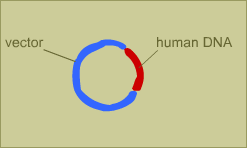 Clones to Sequence
Clones to Sequence
We now have billions of identical copies of a stretch of DNA 2,000 to 4,000
base pairs long. From these we need to create copies with special bases that
our machines will be able to read. Instead of all being exactly alike, though,
these new copies will have varying lengths and will be tagged with colored
markers.
Here is one of our many DNA clones, still attached to the vector. We have
exposed the vector to heat, which has separated its double strand of DNA into
two single strands.
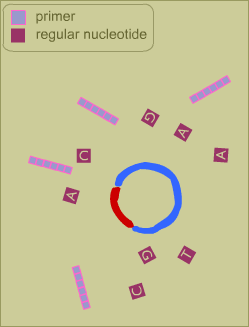 Add Material needed to Build new DNA
Add Material needed to Build new DNA
We next add some of the material needed to construct the complement of the DNA
clone. This includes the "regular" nucleotides (bases) of A's, G's, C's, and
T's, an enzyme known as polymerase (which will help to connect the free
nucleotides to the single strand of cloned DNA), and DNA primers.
A DNA primer is a single-stranded piece of DNA of known sequence, generally
about 20 bases long, that will initiate the building of a new DNA strand that
is complementary to the cloned DNA.
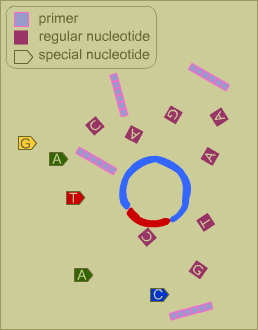 Another Ingredient: "Special" Nucleotides
Another Ingredient: "Special" Nucleotides
To the mix of regular nucleotides, polymerase, and primers we add a small
amount of "special" nucleotides. Because of its molecular structure, whenever
one of these special nucleotides adds itself to a growing DNA strand, the
growth of that strand stops.
These nucleotides are special in another way, too. They fluoresce when struck
by a laser beam. Each type of nucleotide is marked with its own color: A is
marked with green, G with yellow, C with blue, and T with red.
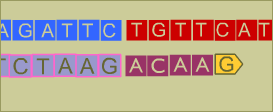 Build New Sequences
Build New Sequences
The primer attaches itself to a complementary sequence on the vector and
initiates the building of a new DNA strand.
To separate the new strand from the vector, we expose them to heat. With the
new strand separated, the building of yet another strand along the original DNA
fragment can begin again. This process is often repeated many times (around 40)
to get the most mileage from each of the billions of vectors present.
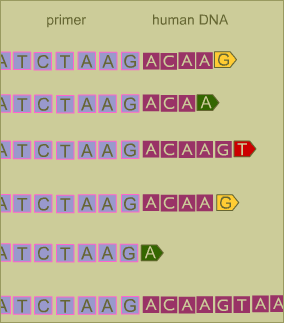 Many Copies of Various Lengths
Many Copies of Various Lengths
Initiated by the primer and with the help of the polymerase, sequence after
sequence is built. Because of the special nucleotides, which get added
occasionally at random locations, the lengths of the new copies range in size
from one to the total number of bases in the vector.
We end up with billions of DNA strands of various lengths, each ending with a
marked nucleotide. Every possible length of the human DNA will have many, many
copies.
Continue: Part IV: Detecting the Sequence
Watch the Program Here |
Our Genetic Future (A Survey)
Manipulating Genes: How Much is Too Much? |
Understanding Heredity
Explore a Stretch of Code |
Nature vs Nurture Revisited
Sequence for Yourself |
Journey into DNA |
Meet the Decoders
Resources |
Update to Program |
Teacher's Guide |
Transcript
Site Map |
Cracking the Code of Life Home
Editor's Picks |
Previous Sites |
Join Us/E-mail |
TV/Web Schedule |
About NOVA
Watch NOVAs online |
Teachers |
Site Map |
Shop |
Search |
To Print
PBS Online |
NOVA Online |
WGBH
© | Updated April 2001
|
|
|